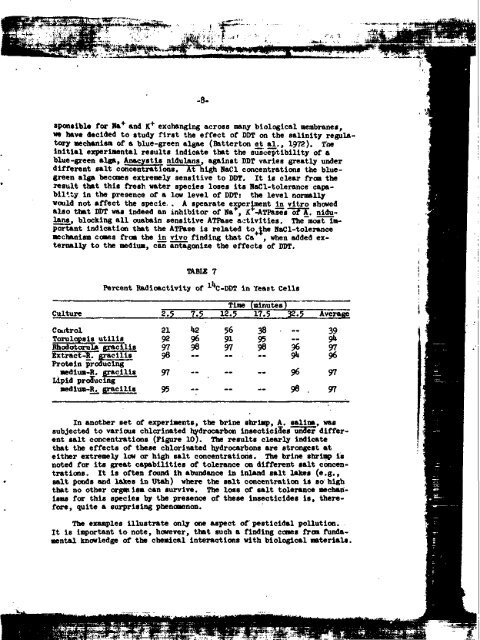Item ID Number - Special Collections
Item ID Number - Special Collections
Item ID Number - Special Collections
Create successful ePaper yourself
Turn your PDF publications into a flip-book with our unique Google optimized e-Paper software.
-8-<br />
sponaible for Na+ and K + exchanging across many biological membranes,<br />
we have decided to study first the effect of DDT on the salinity regulatory<br />
mechanism of a blue-green algae (Batterton et al., 1972). The<br />
initial experimental results indicate that the susceptibility of a<br />
blue-green alga, Anacystis nidulans, against DDT varies greatly under<br />
different salt concentrations. At high NaCl concentrations the bluegreen<br />
alga becomes extremely sensitive to DDT. It is clear from the<br />
result that this fresh water species loses its NaCl-tolerance capability<br />
in the presence of a low level of DDT: the level normally<br />
would not affect the specie. . A spearate experiment in vitro showed<br />
also that DDT was indeed an inhibitor of Na + , X + -ATPases of A. nidulans.<br />
blocking all ouabain sensitive ATPase activities. The most important<br />
indication that the ATPase is related to the Nad-tolerance<br />
mechanism comes from the in vivo finding that Ca , when added externally<br />
to the medium, can antagonize the effects of DDT.<br />
Culture<br />
Control<br />
Torulopsis utilis<br />
Rhodotorula gracilis<br />
Extract-R. gracilis<br />
Protein producing<br />
medium-R. gracilis<br />
Lipid producing<br />
medium-R., gracilis<br />
TABLE 7<br />
Percent Radioactivity of lJ *C-DDT in Yeast Cells<br />
2.5<br />
21<br />
92<br />
97 98<br />
97<br />
95<br />
7.5<br />
U2<br />
96<br />
98<br />
Time<br />
12.5<br />
56<br />
91<br />
97<br />
(minutes )<br />
17.5 32.5<br />
38<br />
95<br />
98<br />
96<br />
96<br />
98 .<br />
Average<br />
39<br />
97<br />
96<br />
97<br />
97<br />
In another set of experiments, the brine shrimp, A. salina, was<br />
subjected to various chlorinated hydrocarbon insecticides under different<br />
salt concentrations (Figure 10). The results clearly indicate<br />
that the effects of these chlorinated hydrocarbons are strongest at<br />
either extremely low or high salt concentrations. The brine shrimp is<br />
noted for its great capabilities of tolerance on different salt concentrations.<br />
It is often found in abundance in inland salt lakes (e.g.,<br />
salt ponds and lakes in Utah) where the salt concentration is so high<br />
that no other organism can survive. The loss of salt tolerance mechanisms<br />
for this species by the presence of these insecticides is, therefore,<br />
quite a surprising phenomenon.<br />
The examples illustrate only one aspect of pesticidal pollution.<br />
It is important to note, however, that such a finding comes from fundamental<br />
knowledge of the chemical interactions with biological materials.
















